Odekon M. Encyclopedia of paleoclimatology and ancient environments
Подождите немного. Документ загружается.


interpreting sediment
231
Pa/
230
Th as a kinematic indicator of
deepwater formation.
Reconstruction of past changes in ocean circulation
during the last glacial-interglacial cycle
Because of its half-life, information from
14
C can only be con-
sidered for the last 50,000 years and we can best constrain past
changes in deep water circulation during that time span. This is
a climatically important and interesting period, as it nearly
encompasses the full range of Quaternary climatic variability.
High-resolution climatic fluctuations over that time period are
documented by the oxygen isotopic composition of the ice that
has accumulated on Greenland (Figure O12), reflecting air
temperature (see Ice cores, Antarctica and Greenland). The
last 10,000 years (i.e., the Holocene period) were charac-
terized by relatively warm (i.e., higher d
18
O in ice) and stable
conditions. In contrast, the preceding glacial period, when
large ice sheets covered the North American and European
continents, was characterized by large climatic fluctuations.
These fluctuations are called Dansgaard-Oeschger cycles and
consist of abrupt warmings followed by more gradual coolings.
The transition to the Holocene, which coincided with the melt-
ing of most of the large northern continental ice sheets, was
also punctuated by an abrupt warming 15,000 years ago
(Bølling), followed by a brief cold reversal (Younger Dryas)
at 12,800 yr
BP., and a rapid final warming at 11,600 yrBP.
Changes in the distribution of deep-water masses
One of the most robust deductions derived from the water mass
proxies is that climatic variability was associated with vertical
redistribution of nutrient concentrations in the water column
of the Atlantic. Nutrient concentrations at intermediate depths
(above 2,500 m) were lower during the last glacial period
compared to today, while they were higher in deeper waters
(below 2,500 m). This has been corroborated by the d
13
C,
Cd/Ca and Zn/Ca ratios of benthic foraminifera (Figure O13).
Lower nutrient concentrations in glacial intermediate waters
have been taken as reflecting the formation of a shallower
water mass in the North Atlantic (the Glacial North Atlantic
Intermediate Water, GNAIW) in lieu of today’s NADW, while
higher nutrient concentrations in deep water have been taken
Figure O11 Schematic representation of the principle for estimating
the rate of NADW formation from
231
Pa /
230
Th in marine sediments.
231
Pa and
230
Th are produced uniformly in seawater from the decay of
dissolved uranium (b
Pa
/ b
Th
= production rate ratio). Because of its
shorter residence time in the water column, nearly all the
230
Th
produced in the NADW during transit through the Atlantic is removed
in the underlying sediment. On the other hand, since the residence
time of
231
Pa in seawater is similar to the residence time of deep water
in the Atlantic, approximately half of the
231
Pa produced in the
Atlantic is exported into the Southern Ocean with NADW. The resulting
deficit of
231
Pa in Atlantic sediment increases with the rate of NADW
formation and export to the Southern Ocean.
Figure O12 Oxygen isotopic composition (d
18
O) of the ice that accumulated on Greenland during the last 60,000 years (Grootes et al., 1993).
Higher d
18
O indicates higher temperature. LGM: Last Glacial Maximum (the time of maximum continental ice buildup). YD: Younger Dryas cold
period. B/A: Bølling-Allerod warm period. H1 to H6 mark the timing of 6 massive iceberg discharge events recorded as high accumulation of
ice-rafted debris in the North Atlantic, coinciding with the coldest periods (lowest d
18
O) recorded in the ice core.
640 OCEAN PALEOCIRCULATION
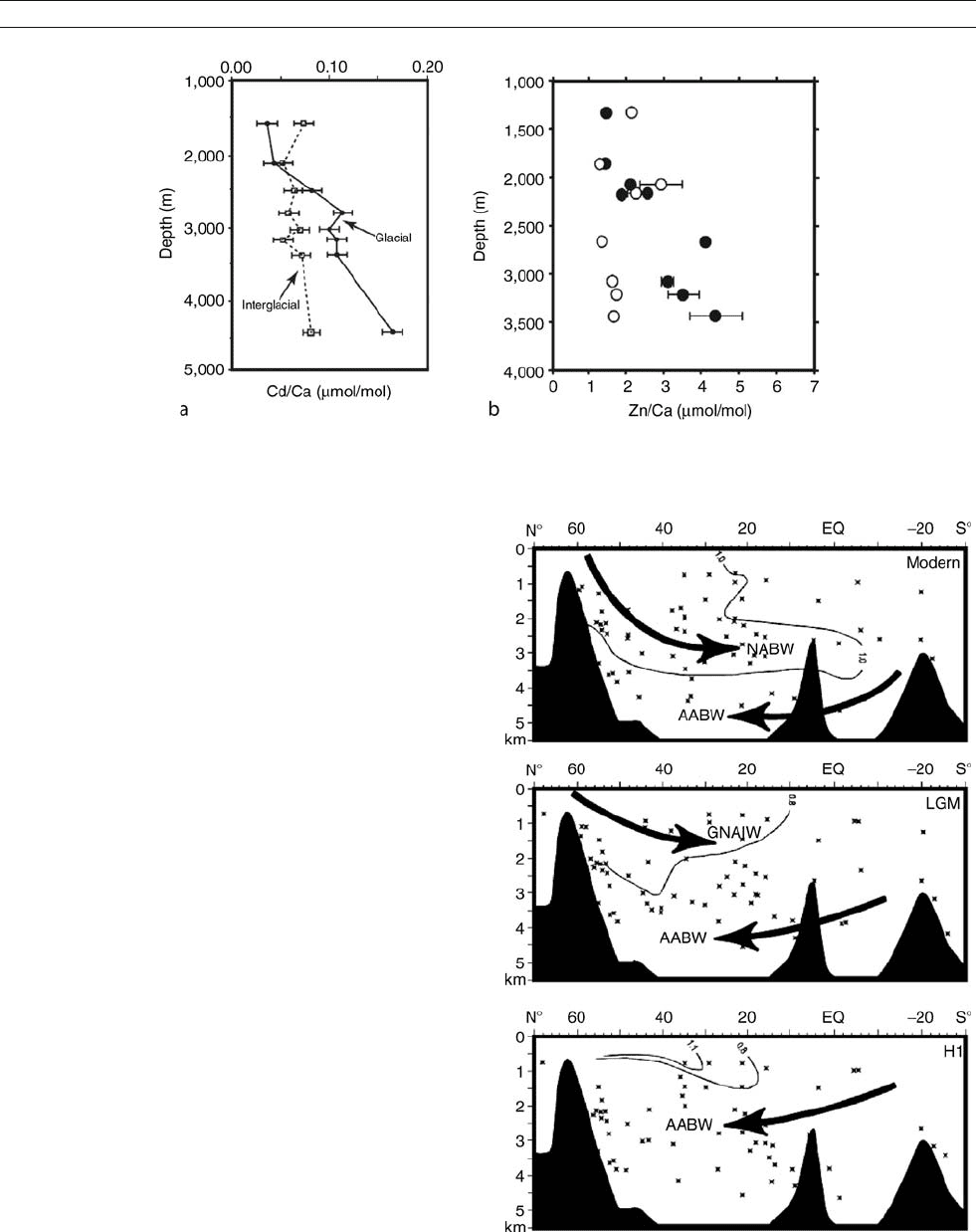
as indicating increased penetration of deep water of southern
origin into the North Atlantic. Higher nutrient concentrations
in the deep Atlantic could also reflect higher preformed nutrient
concentration in North Atlantic surface waters or higher remi-
neralization of organic matter in deep waters. However, the
similarity between the benthic foraminifera record of Zn/Ca
and Cd/Ca in the North Atlantic argues against dramatic
changes in preformed nutrient concentrations (Marchitto et al.,
2002). Increased penetration of southern water during the last
glacial period has also been confirmed by e
Nd
, which is inde-
pendent of nutrient recycling (Rutberg et al., 2000). The more
extensive d
13
C database (Sarnthein et. al., 2001) clearly shows
increased northward penetration of southern water and replace-
ment of the modern NADW by the shallower GNAIW during
the last glacial maximum (Figure O14a,b). Combining d
13
C
and Cd/Ca, Lynch-Stieglitz et al. (1996) provided evidence
that the shallower GNAIW propagated to the Pacific Ocean,
in a similar manner as today’s NADW (Figure O7).
A third mode of deepwater mass distribution has also been
identified from the distribution of benthic foraminifera d
13
C,
in which deepwater formation from the north was essentially
eliminated and the entire water column of the Atlantic Ocean
below the main thermocline was filled with water of southern
origin (Figure O14c). This situation seems to arise during the
coldest intervals of the glacial periods, which are associated
with catastrophic iceberg discharges, called Heinrich Events
(Figure O12). These events are recorded in the sediments of
the North Atlantic as discrete layers of coarse-grained ice-rafted
debris that are deposited as the icebergs melt. The shutdown of
deep-water formation in the North Atlantic during these events
has been attributed to melting of icebergs and lowering of the
density of surface waters in areas of deepwater formation.
Changes in the rate of formation of deepwater masses
As pointed out by Legrand and Wunsch (1995), water mass tra-
cers alone cannot uniquely constrain rates of deep-water forma-
tion. Doing so requires kinematic tracers. The initial study
using
231
Pa/
230
Th in Atlantic sediments (Yu et al., 1996)
reached the surprising conclusion that the rate of deep water
Figure O13 Vertical redistribution of nutrients in the Atlantic Ocean during the last glacial period recorded by (a) Cd /Ca (adapted from Boyle,
1988), (b) Zn /Ca (adapted from Marchitto et al., 2002) in benthic foraminifera. Open symbols: Holocene profile; closed symbols: glacial profile.
Figure O14 Vertical transects of benthic foraminifera d
13
C in the
Atlantic Ocean (a) Modern (b) Last glacial maximum (c) Heinrich event
H1 (adapted from Sarnthein et al., 2001).
OCEAN PALEOCIRCULATION 641
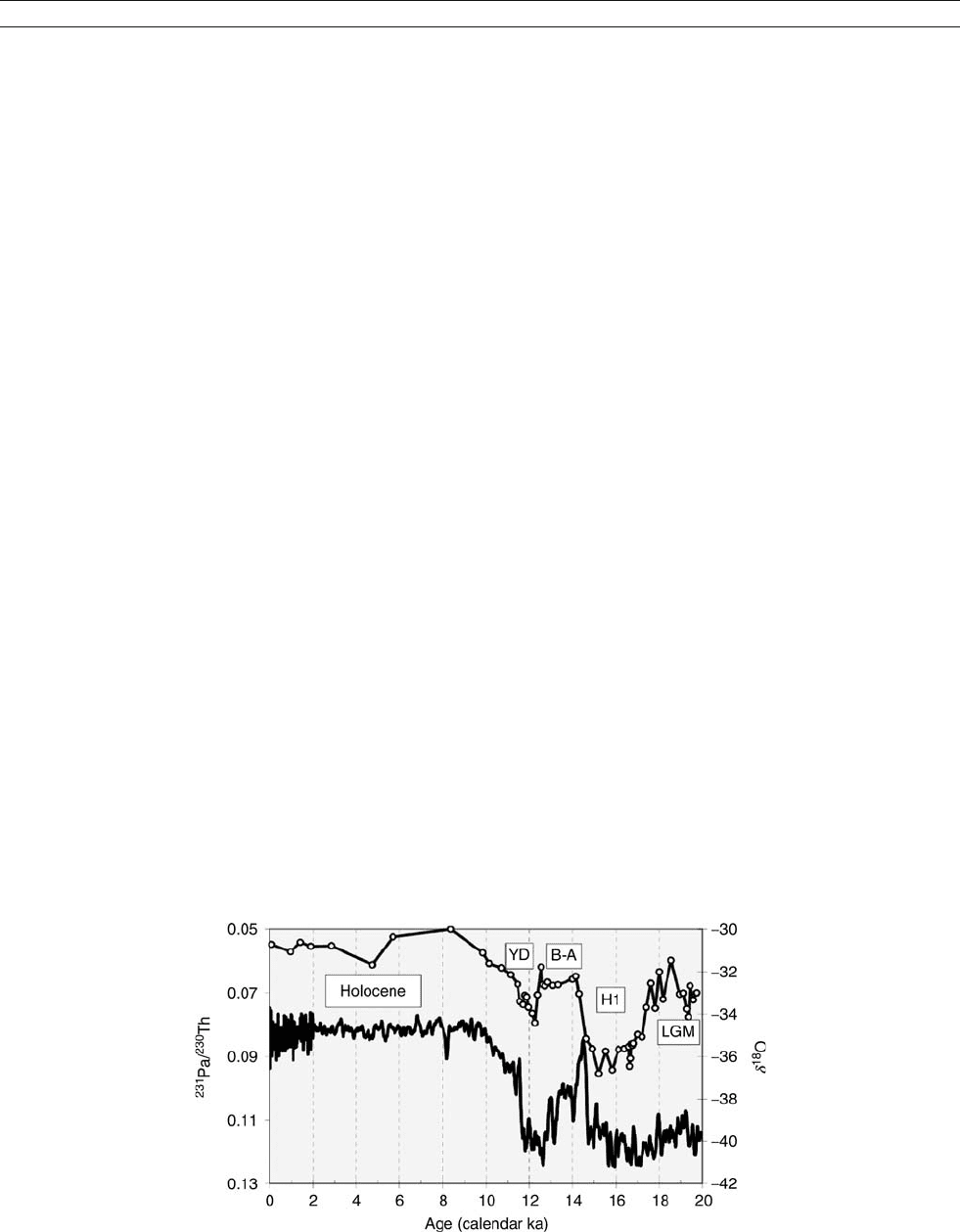
formation in the North Atlantic during the last glacial maxi-
mum (GNAIW) and its export to the southern ocean was little
different from today’s rate of formation and export of NADW.
The uncertainties on this estimate were quite large however,
and the subsequent use of a zonally integrated general circula-
tion model indicated that the existing data were not inconsistent
with a possible 30% glacial reduction (Marchal et al., 2000).
Reconstruction of the slope of the isopycnals in Florida Straits
also suggested a 30% reduction in the rate of GNAIW forma-
tion (Lynch-Stieglitz et al., 1999), although this estimate also
has very large uncertainties (Wunsch, 2003).
A high-resolution
231
Pa/
230
Th profile obtained by analyzing a
core retrieved from a drift deposit in the central North Atlantic
provides important additional insights into the relationship
between the rate of northern source deepwater formation and cli-
matic variability (Figure O15). This record confirms the steady
formation of NADW over the entire Holocene period at a rate
similar to present (i.e.,
231
Pa/
230
Th 0.055). It also suggest a
slight reduction of the rate of GNAIW formation during the last
glacial maximum (i.e.,
231
Pa/
230
Th 0.068 between 17,500 and
20,000 yr
BP.), although this higher
231
Pa/
230
Th may be partly
due to the higher particle fluxes at that time. The most prominent
feature of this new record, however, is the rapid increase in
231
Pa/
230
Th to values similar to the rate of production (0.093)
between 17,500 and 15,000 yr
BP. This indicates that the forma-
tion of northern source deep water had totally ceased for a period
of 2,500 years (particle fluxes decreased during that time inter-
val and cannot account for the observation), and coincided with
the more recent Heinrich Event (H1; Figure O12). Deepwater
formation in the North Atlantic re-started abruptly at 15,000
yr
BP., coinciding with a rapid climate warming (Bølling) and a
rapid rise in sea level. The latter must have been the result of
accelerated melting of continental ice. A significant but lesser
decrease in the rate of deepwater formation also occurred during
the cold Younger Dryas period, followed by a gradual accelera-
tion into the Holocene.
There is a good general agreement between this interpreta-
tion of
231
Pa/
230
Th in North Atlantic sediment (McManus et al.,
2004) and the reconstruction of atmospheric D
14
C (Hughen
et al., 1998, 2004). Comparing the latter with D
14
C
atm
predicted
from the changes in the intensity of the geomagnetic field
reveals deviations that are consistent with slower rates of trans-
fer of
14
C from the atmosphere to the deep sea (i.e., lower rates
of deepwater formation) during the Younger Dryas cold period
and Heinrich Event H1.
14
C ages of
230
Th-dated deep-sea corals suggest that changes
in the rates of deepwater circulation may have been very
abrupt. Adkins et al. (1998) have shown that within a period
of 130 years, the
14
C age of bottom water at 40
N in the
Western Atlantic at 1,800 m depth decreased by 670 years, sug-
gesting an abrupt slowdown of deepwater formation rate at a
time (15,400 yr
BP.) that preceded the Bølling warming. This
observation indicates that deepwater formation rates could
have fluctuated on centennial timescales, i.e., a “flickering ” rate
too rapid to be recorded in the
231
Pa/
230
Th record. However,
a detailed reconstruction of deep water circulation on this
timescale, using the narrow windows of information both
in time and space provided by deep-sea corals, requires the
further analysis of a large number of widely-distributed coral
specimens.
Conclusion
Much remains to be done to obtain a detailed and accurate
reconstruction of past changes in deep water circulation, even
during the relatively recent past of the late Quaternary. It is evi-
dent that none of the proxies used for water mass identification
and circulation rates provides a simple, straightforward answer.
Each proxy is affected by factors other than deepwater circula-
tion and the circulation signal must be retrieved from a tangle
of other influences. It is therefore important not to rely on a sin-
gle tracer, but to use the full range of circulation proxies that is
at our disposal. Apparent disagreements point to problems with
the interpretation of at least some of the proxies and through an
iterative process of proxy validations in the modern ocean,
paleoceanographic reconstructions, and cross examinations,
we gradually converge towards a better understanding of past
ocean circulation. This endeavor is crucial not only to under-
stand past climatic variations but also to improve our ability
at predicting future climate changes that could potentially be
triggered by human activity.
The picture that is slowly emerging suggests that during the
last glacial period, GNAIW was generally produced at a rate
that was not dramatically different from the modern rate of
NADW formation. It also seems that, as is the case for the
modern NADW (Figure O7), the GNAIW was part of a global
“conveyor belt” circulation. However, this only ventilated the
Figure O15
231
Pa /
230
Th in a high sedimentation rate core from the North Atlantic (adapted from McManus et al., 2004) compared to the d
18
Oin
Greenland ice. Low
231
Pa /
230
Th = high NADW formation rate (note the reverse scale); higher d
18
O = warmer temperature.
642 OCEAN PALEOCIRCULATION

upper 2,500 m of the ocean. Below that depth, deep waters pre-
sumably originating from the southern ocean were present. In
contrast to this apparent lack of correlation between rates of
deepwater formation and climate on these longer time scales,
there seems to be a much closer relationship on shorter time-
scales. During short periods of massive iceberg discharge
(Heinrich Events) that punctuated the glacial period, deepwater
formation in the North Atlantic may have totally ceased. The
rapid warmings that followed these events seem to be the
results of a rapid reinvigoration of the Atlantic MOC. Such a
sequence of events has now been well documented for the last
of the Heinrich Events (H1), which occurred during the early
stages of the deglacial transition into the Holocene. Water mass
proxies suggest similar sequences during the other Heinrich
events, but confirmation with kinematic tracers is still required.
The possibility that some of the abrupt climate changes in the
past were associated with rapid changes in the rate of thermo-
haline circulation raises concerns that such events could happen
in the near future.
Roger Francois
Bibliography
Adkins, J.F., and Boyle, E.A., 1997. Changing atmospheric D
14
C and the
record of deep water paleoventilation age. Paleoceanography, 12,
337–344.
Adkins, J.F., Cheng, H., Boyle, E.A., Druffel, E.R.M., and Edwards, R.L.,
1998. Deep-Sea coral evidence for rapid change in ventilation of the
deep North Atlantic 15,400 years ago. Science, 280, 725–728.
Bard, E., 1988. Correction of accelerator mass spectrometry C-14 ages
measured in planktonic foraminifera: Paleoceanographic implications.
Paleoceanography, 3, 635–645.
Boyle, E.A., 1986. Paired carbon isotope and cadmium data from benthic
foraminifera: Implications for changes in oceanic phosphorus, oceanic
circulation, and atmospheric carbon dioxide. Geochim. Cosmochim.
Acta, 50, 265–276.
Boyle, E.A., 1988. Cadmium: Chemical tracer of deepwater paleoceanogra-
phy. Paleoceanography, 3, 471–489.
Broecker, W.S., 1997. Thermohaline circulation, the Achilles heel of our
climate system: Will man-made CO
2
upset the current balance? Science,
278, 1582–1588.
Broecker, W.S., and Maier-Reimer, E., 1992. The influence of air and sea
exchange on the carbon isotope distribution in the sea. Global Biogeo-
chem. Cycles, 6, 315–320.
Hughen, K.A., Overpeck, J.T., Lehman, S.J., Kashgarian, M., Southon, J.,
Peterson, L.C., Alley, R.B., and Sigman, D., 1998. Deglacial changes
in ocean circulation from an extended radiocarbon calibration. Nature,
391,65–68.
Hughen, K.A., Lehman, S.J., Southon, J.N., Overpeck, J.T., Marchal, O.,
Herring, C., and Turnbull, J., 2004.
14
C activity and global carbon cycle
changes over the past 50,000 years. Science, 302, 202–207.
Intergovernmental Panel on Climate Change 2001. Climate Change 2001:
Synthesis Report. Contribution of Working Group I, II and III to the
Third Assessment Report of the Intergovernmental Panel on Climate
Change. Cambridge, UK: Cambridge University Press.
Keigwin, L.D., and Schlegel, M.A., 2002. Ocean ventilation and sedimenta-
tion since the glacial maximum at 3 km in the western North Atlantic.
Geochem. Geophys. Geosyst., 3(6), 1034 (doi: 10.1029/2001GC000283).
Kroopnick, P.M., 1985. The distribution of C-13 of TCO
2
in the world
oceans. Deep Sea Res., 32,57–84.
Laj, C., Kissel, C., Mazaud, A., Michel, E., Muscheler, R., and Beer, J.,
2002. Geomagnetic field intensity, North Atlantic Deep Water circula-
tion and atmospheric D
14
C during the last 50 kyr. Earth Planet. Sci.
Lett., 200, 177–190.
Lea, D.W., 1993. Constraints on the alkalinity and Circumpolar deep water
from benthic foraminiferal barium. Global Biogeochem. Cycles, 7,
695–710.
Lea, D., and Boyle, E.A., 1989. Barium content of benthic for-
aminifera controlled by bottom-water composition. Nature, 338,
751–753.
LeGrand, P., and Wunsch, C., 1995. Constraints from paleo-tracer data on
the North Atlantic circulation during the last glacial maximum. Paleo-
ceanography, 10, 1011–1045.
Lynch-Stieglitz, J., van Geen, A., and Fairbanks, R.G., 1996. Interocean
exchange of glacial North Atlantic Intermediate Water: Evidence from
subantarctic Cd /Ca and carbon isotope measurements. Paleoceanogra-
phy, 11, 191–201.
Lynch-Stieglitz, J., Curry, W.B., and Slowey, N.C., 1999. Weaker Gulf
Stream in the Florida Straits during the last glacial maximum. Nature,
402, 644–648.
Marchal, O., Francois, R., Stocker, T.F., and Joos, F., 2000. Ocean thermo-
haline circulation and sedimentary
231
Pa/
230
Th ratio. Paleoceanogra-
phy, 15, 625–641.
Marchitto, T.M., Curry, W.B., and Oppo, D.W., 2000. Zinc concentrations
in benthic foraminifera reflect seawater chemistry. Paleoceanography,
15, 299–306.
Marchitto, T.M., Oppo, D.W., and Curry, W.B., 2002. Paired benthic fora-
minifera Cd/Ca and Zn/ Ca evidence for a greatly increased presence of
southern ocean water in the glacial North Atlantic. Paleoceanography,
17(3), 1038 (doi: 10.1029 /2000PA00059).
McManus, J.F., Francois, R., Gherardi, J., Keigwin, L.D., and Brown-
Leger, S., 2004. Rapid d eglacial changes in Atlantic meridional
circulation recorded in sedimentary
231
Pa/
230
Th. Nature, 428,
834–837.
Rutberg, R.L., Hemming, S.R., Goldstein, S.L., 2000. Reduced North
Atlantic Deep Water flux to the glacial southern ocean inferred from
neodymium isotope ratios. Nature, 405, 935–938.
Sarnthein, M., and 18 others, 2001. Fundamental modes and
abrupt changes in North Atlantic circulation and climate over the
last 60 ky – Concepts, reconstruction and numerical modeling. In
Schäfer, P., Ritzau, W., Schlüter, M., Thiede, J. (eds.), The Northern
North Atlantic: A Changing Environment. Berlin: Springer Verlag, pp.
45–66.
Toggweiler, J.R., 1999. Variation of atmospheric CO
2
by ventilation of the
ocean’s deepest water. Paleoceanography, 14, 571–588.
von Blanckenburg, F., 1999. Tracing past ocean circulation? Science, 286,
1,862–1,863.
Worthington, L.V., 1976. On the North Atlantic circulation, The Johns
Hopkins Oceanographic Studies, Vol. 6. Baltimore, MD: Johns Hopkins
University Press, 110pp.
Wunsch, C., 2003 Determining paleoceanographic circulations, with
emphasis on the last glacial maximum. Quaternary Sci. Rev., 22,
371–385.
Yu, E.-F., Francois, R., and Bacon, M.P., 1996. Similar rates of modern and
last-glacial ocean thermohaline circulation inferred from radiochemical
data. Nature, 379, 689–694.
Cross-references
Antarctic Bottom Water and Climate Change
Carbon isotopes, Stable
Coral and Coral Reefs
Dansgaard-Oeschger Cycles
Dating, Radiometric Methods
Foraminifera
Heinrich Events
Ice Cores, Antarctica and Greenland
Last Glacial Termination
North Atlantic Deep Water and Climate Change
Ocean Paleoproductivity
Quaternary Climate Transitions and Cycles
Radiocarbon Dating
Thermohaline Circulation
Uranium-Series Dating
OCEAN PALEOPRODUCTIVITY
OCEAN PALEOPRODUCTIVITY 643
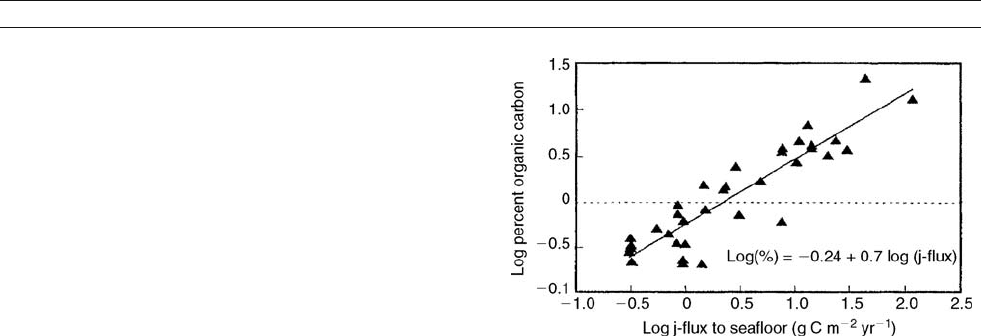
Introduction
Ocean productivity – the uptake of dissolved inorganic carbon
and its sequestration into organic compounds by marine primary
producers – plays a major role in controlling the partitioning of
carbon between the ocean and atmosphere. Productivity fluctua-
tions can therefore influence climate by altering the atmospheric
concentrations of the greenhouse gas carbon dioxide (Berger et al.,
1989). In addition, changes in marine productivity have some
bearing on the biogeochemistry of many trace elements (P, N, Si,
Ba) and gases (dimethyl sulfide). The record of significant fluc-
tuations in atmospheric carbon dioxide in air trapped within polar
ice along with the increasing concern of potential climate warming
induced by industrial carbon dioxide emissions has emphasized
the need to understand the interrelationship between productivity,
ocean chemistry, atmospheric carbon dioxide, and climate. Ocean
paleoproductivity studies document past changes in the biological
production of organic matter and skeletal material. These studies
provide insight into the causes of such fluctuations, the conse-
quences for biogeochemical cycles within the ocean, and their cor-
respondence to Earth’s climate.
There are two components of oceanic productivity that are
of interest: (a) net primary production in the surface ocean; and
(b) export production, which is the fraction of net primary produc-
tion that leaves the surface ocean and sinks to the deep ocean.
While the former is of interest for learning about oceanic ecosys-
tems, and carbon and nutrient cycling within the ocean, the latter
is more relevant for carbon sequestration and climate change.
The unit for measuring productivity is flux of carbon (grams
Cm
2
yr
1
) and typical values for open ocean net primary prod-
uctivity today are 25–250 g C m
2
yr
1
. Export production typi-
callyrangesfromlessthan10%andupto50%ofthenet
primary production.
The concept of changing oceanic productivity and the relation
of such changes to climate stand at the beginning of paleocea-
nographic research. Arrhenius (1952) suggested such changes to
explain the sedimentary record and in particular calcite accumulation
and size distribution of a diatom (Coscinodiscus nodulifer)
over time in the eastern Equatorial Pacific. Since direct measure-
ments of carbon uptake or flux to the deep ocean cannot be done
for past times, paleoproductivity reconstruction has been based
on records obtained from marine sediments. Over the past
50 years, a large variety of methods has been applied to recon-
struct productivity, attesting to the importance of this field. Some
of these methods result only in qualitative estimates while others
are more quantitative. Each of these methods (or proxy variables
for productivity) has associated assumptions and limitations and
therefore should be used with caution. Ideally, several proxies
should be applied simultaneously at any gives site or time inter-
val to evaluate changes in marine productivity.
Reconstruction of productivity from organic matter
or phosphorus in sediments
As a dominant biological component, measurements of organic
carbon (C) content of sediments seem a logical choice for recon-
structing biological C production. In areas removed from down-
slope transport of fine-grained material, it has been assumed that
the flux of organic C reaching the sediment is proportional to its
net export from the surface ocean (Figure O16). Indeed, sediment
trap studies indicate that a general relation between the flux of
organic matter to the deep sea and productivity exists. However,
there is a strong depth dependence of the relation because of
organic C degradation in the water column. Only a small fraction
of the organic matter that arrives to the sediment is ultimately
buried. However, at least at some oceanic locations, a relation
between the abundance of organic matter in sediments and pri-
mary production has been observed. Empirical equations that
quantitatively relate the accumulation rate of organic carbon in
sediments to overlying productivity (Muller and Suess, 1979)or
to the carbon flux to the seafloor (Sarnthein et al., 1988) have been
suggested using data from the present ocean. The relation between
organic matter content and productivity has been applied to reco-
nstruct past oceanic productivity in various oceanic basins and
for various time scales (Muller and Suess, 1979; Pedersen, 1983;
Finney et al., 1988).
The interpretations of the fluctuations of organic carbon con-
tent in terms of paleoproductivity are complicated by processes
affecting organic matter preservation such as sediment accumu-
lation rates, deep water oxygen content, exposure time, and
mineral surface area (Emerson, 1985; Keil et al., 1994). In addi-
tion, supply of organic C from terrestrial origin may result in
overestimation of the oceanic productivity in coastal environ-
ments (Goni et al., 1998).
One of the elements directly related to organic matter is phos-
phorus (P). Phosphorus is an important nutrient to all living organ-
isms. In general, marinephytoplanktonincorporateP at a relatively
constant ratio to their C content (the Redfield molar ratio of 106 C
to 1 P). Accordingly, mappingpast P accumulation may provide an
indirect estimate of C flux and thus productivity (Delaney, 1998).
Indeed, this proxy has been used to reconstruct past ocean produc-
tivity, typically over long geological time frames where organic C
dataismore likelytobecompromised(Filippelli,2002).
It must be kept in mind, however, that only a small fraction of
P is preserved in the sediment (like C) and that, within the sedi-
ment after burial, P is transformed from the organic forms to
authigenic minerals (Ruttenberg and Berner, 1993). To account
for this complication, the “reactive P” fraction, which is the P
that presumably was associated with organic matter, is used for
paleoproductivity reconstruction (Delaney, 1998). In addition,
post burial redox diagenesis may alter the P association and
preservation in the sediment and therefore care must be taken to
avoid samples that have been compromised by such processes
(Delaney, 1998).
Figure O16 Correlation of organic carbon content in marine
sediments with organic matter flux to the seafloor (after Berger and
Herguera, 1992).
644 OCEAN PALEOPRODUCTIVITY
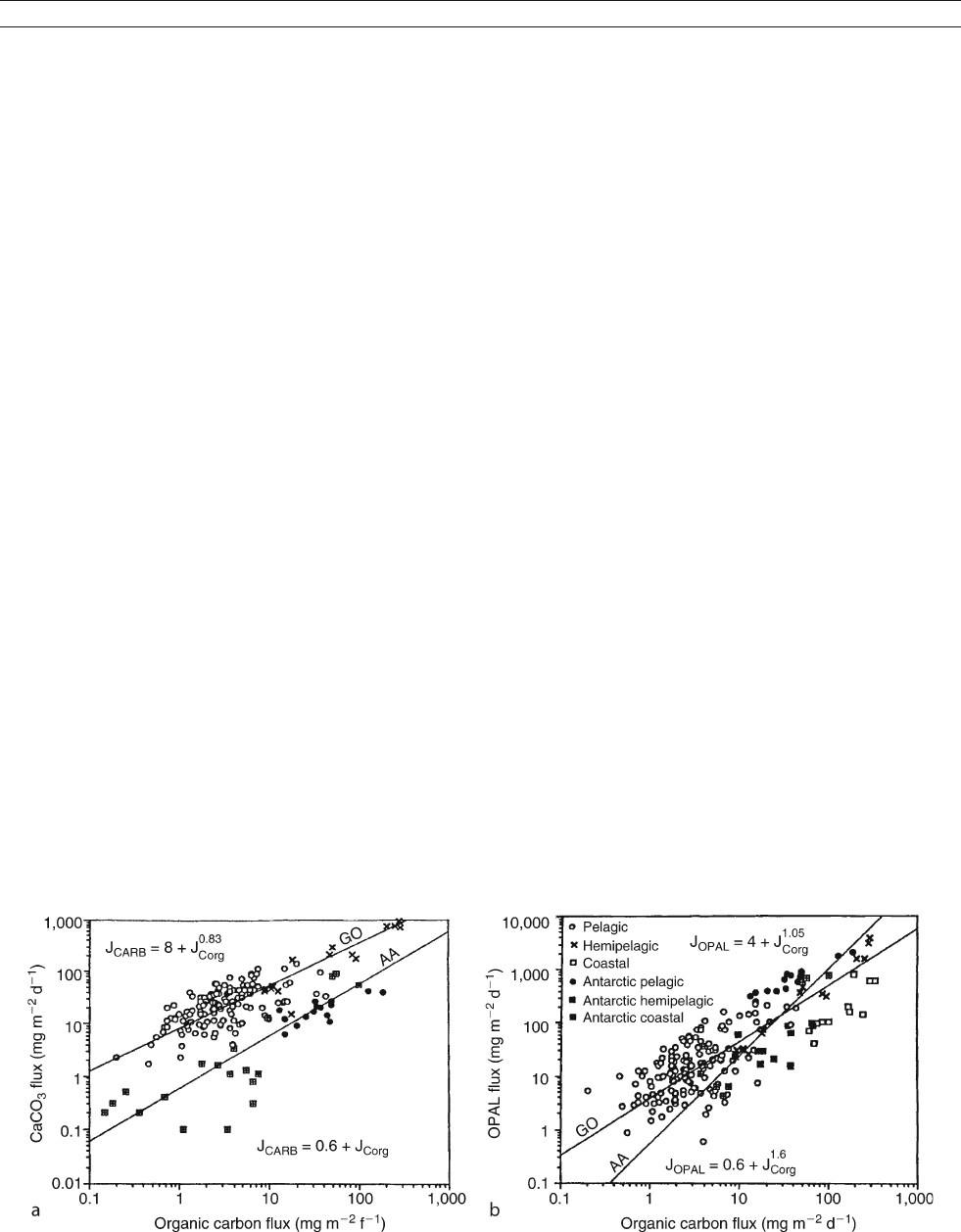
Reconstruction of productivity from carbonate or opal
Geologists have long recognized that variations in sediment com-
position parallel surface primary production. Indeed calcium car-
bonate and biogenic opal in marine sediments are predominantly
composedof the hard parts of marine organisms (coccolithophores
and diatoms). Sediment traps show a good correlation between the
organic C flux and carbonate flux under certain conditions in the
open ocean above the lysocline (Deuser et al., 1981; Ruhlemann
et al., 1996)(Figure O17a). Similarly biogenic opal flux in sedi-
ment trapsand on the seafloor generallycorrelates with the organic
C flux (Calvert, 1966)(Figure O17b). These empirical relations
based on traps and core top sediments can be used as a basis for
reconstructing changes in location and intensity of export produc-
tion. Indeed, Lyle et al. (1988) demonstrate linkage between mass
accumulation rates of organic C, calcite, and biogenic opal and
tie these to biological productivity.
Both these proxies, however, represent only changes in the
export production of the specific organisms precipitating these
minerals. One must therefore assume a predictable relation be-
tween total export production and the production of specific
groups of organisms that are responsible for the precipitation of
these minerals. Moreover, opal fluxes to the sediment may be
dominated by event production such as during diatom blooms.
In addition, both proxies are affected by a variety of physical and
chemical oceanographic processes and not only by productivity.
In particular, because the ocean is undersaturated everywhere with
respect to opal, there is a major problem in quantitatively relating
the amount of opal preserved in sediments to its production in the
water column. Opal preservation rates depend on several factors
including the global silica budget, pore water dissolved silica con-
centration, the thermal history of the sediment column, and the
degree of silicification of the frustules (DeMaster, 1981; Treuger
et al., 1995; Hutchins and Bruland, 1998). As a result, areas with
high opal accumulation do not always correspond with areas of
high productivity such as in the present-day Southern Ocean.
Nevertheless, there do appear to be major trends in the history of
opaline sedimentation over time and this proxy has been used to
suggest qualitative changes in export production. Similarly,
calcium carbonate accumulation in marine sediments may also
suffer severe diagenetic modification of the original productiv-
ity-driven signal due to dissolution. This process, however, will
occur predominantly in the deeper parts of the ocean where
seawater is undersaturated with respect to calcite. With proper
site selection, or after accounting for dissolution (Mekik et al.,
2002), it is possible to obtain representative patters of carbonate
production in most areas of the world’s ocean.
Reconstruction of productivity from barite and Ba
accumulation
Marine barite (BaSO
4
), the major carrier of particulate Ba in the
water column, is related to the marine carbon export flux (Bishop,
1988;Dymondetal.,1992). Barite precipitation in the water col-
umn is associated with decaying organic matter (Ganeshram et al.,
2003). This results in a positive correlation between barite and
excess-Ba (the Ba fraction not carried by terrigenous material –
Ba
excess
) and organic carbon fluxes in sediment traps and filtered
particulate matter (Dehairs et al., 1980; Dymond et al., 1992).
Based on this relationship in sediment traps, Dymond et al.
(1992) predicted a positive correlation between the accumulation
of Ba
excess
in marine sediments and carbon export (Figure O18a).
Ba
excess
has been used in many studies, to infer paleoproduc-
tivity (Nürnberg et al., 1997;Bonnetal.,1998; Bains et al.,
2000). Ba
excess
is determined from the total Ba concentration in
the sediment after subtracting the Ba associated with terrigenous
material, which is calculated from total Al or Ti, and normalization
to a constant detrital Ba/Al or Ba/Ti ratio. This calculation
assumes that (a) all sedimentary particulate Ba besides the fraction
associated with terrigenous aluminosilicates is predictably related
to carbon export, (b) all of the Al (or Ti) is associated with terri-
genous material, and (c) the Ba/Al (Ba/Ti) ratio used for normal-
ization is in fact representative of each sample’s terrigenous
component and is constant in space and time. If the above assump-
tions are correct then Ba
excess
accumulation in sediments could be
used to estimate carbon export.
Paytan et al. (1996) and Eagle et al. (2003) proposed an
algorithm for paleoproductivity reconstruction based directly
on barite accumulation in core top sediments (Figure O18b).
In these studies, as in Dymond et al. (1992), the applicability
of the proxy relies on the observation that barite forms and
accumulates in proportion to biological productivity and the
organic matter flux in the water column. In addition, barite
shows promise as a paleoproductivity proxy because it is a
highly refractory mineral with preservation as high as 30% in
oxic sediments (Dymond et al., 1992). The barite accumulation
Figure O17 Relationship between (a) carbonate and (b) opal flux and organic carbon flux in sediment traps from various regions in the ocean. GO:
global ocean; AA: Southern Ocean (after Berger and Herguera, 1992).
OCEAN PALEOPRODUCTIVITY 645
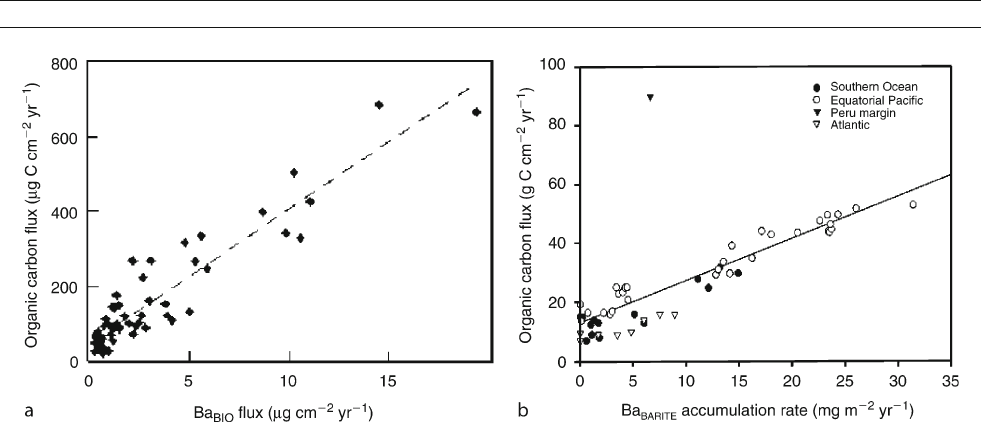
rate in oxic sediments could therefore serve as a proxy for esti-
mating paleocarbon export if the processes controlling barite
formation and preservation are known and operate globally in
the ocean.
Barium, however, is contained in other phases, some of
which are biogenically-related (e.g., organic matter, biogenic
silica, and biogenic carbonate), and others that are not directly
related to carbon export (e.g., terrigenous silicates, Fe-Mn
oxides, and hydroxides). The non-barite phases that are included
in Ba
excess
would not necessarily yield a predictable global
C
org
/Ba
excess
relationship as found by Dymond et al. (1992).
This is because the ratio of organic carbon to these other
biologically-related Ba phases varies spatially in the ocean, and
because factors controlling Ba incorporation into Fe-Mn oxides
and hydroxides are not directly biologically mediated. Although
barite accumulation is not affected by the above factors, its preser-
vation is affected by the dissolved Ba concentration in seawater;
thus, some estimate of past oceanic Ba concentrations is needed
for quantitative use of this proxy. In addition, barite in marine
sediments is remobilized under sulfate-reducing conditions, so
this proxy can only be applied when pore waters have remained
saturated with respect to barite throughout the sedimentary record.
Reconstruction of productivity from microfossil
assemblages
The use of species distribution has been widely applied for
reconstructing productivity. Plankton assemblages in the sur-
face ocean respond to nutrient concentrations, thus productiv-
ity. A number of foraminifera species have been identified as
indicative of high productivity (Globigerina bulloides, Neoglo-
boquadrina dutertrei and Globorotalia tumida at low latitudes,
Globigerina quinqueloba in temperate latitudes and Neoglobo-
quadrina pachyderma in cold upwelling waters). Single species
abundances, however, may be more indicative of upwelling or
other hydrographic physical processes rather than biological
productivity. Multi-species based indexes using all of the fora-
minifera species in sediment cores to construct a quantita-
tive estimate of productivity using standard transfer function
techniques are more robust (Imbrie and Kipp, 1971). The trans-
fer functions (modern analogs) are constructed using modern
primary production rates and a global coverage of core top
foraminifera abundance data (Mix, 1989). The high abundance
and diversity of foraminifera allows statistical analyses of small
sediment samples (Figure O19a).
Similarly, the benthos biomass and the structure of the benthic
community (species composition and size) reflect the supply of
organic matter to the seabed, thus export production (Rowe,
1983). In particular, benthic foraminifera, which constitute a
major portion of the benthic biomass, respond to changes in sup-
ply of organic carbon to the seafloor. Accordingly, changes in
benthos abundance (population size) and benthic population
composition (assemblage) have been used to qualitatively indi-
cate changes in export production (Figure O19b). The biomass
of total benthic foraminifera is positively correlated with the esti-
mated local annual flux of organic C into the deep sea (Herguera,
2000). Specific species such as Uvigerina peregrina and Globo-
bulimina sp. are characteristic of high nutrient fluxes, whereas
Cibicidoides wuellerstorfi and Cibicidoides kullenbergi biofa-
cies dominate areas of low productivity (Altenbach and
Sarnthein, 1989). Transfer functions based on benthic commu-
nities and diatom assemblages have also been developed and
applied to reconstruct past oceanic productivity (Loubere, 1999).
Many uncertainties remain, however, because our knowledge
of the biology of the common fossil groups is limited. It is not
clear to what extent the plankton assemblage reflects primary
production, export production, or food availability. In addition,
assemblages respond to a complex suite of environmental para-
meters that are not easily separated, thus are affected by other
environmental variables (temperature, salinity, oxygen, etc.). Pro-
blems may arise from non-analog situations where the calibration
using present-day core top samples does not represent past condi-
tions. In addition, for all the species indices, there may be preser-
vation effects and post-deposition changes in assemblages due to
preferential dissolution, which will limit our ability to see true
biological relationships. For longer time frames, evolution of spe-
cies will also limit the utility of this type of index.
Figure O18 (a) Relation between excess Ba and organic C export in sediment traps (modified from Dymond et al., 1992). (b) Relation between
barite accumulation rate in core top sediments and carbon export in the overlying water column (modified from Eagle et al., 2003).
646 OCEAN PALEOPRODUCTIVITY
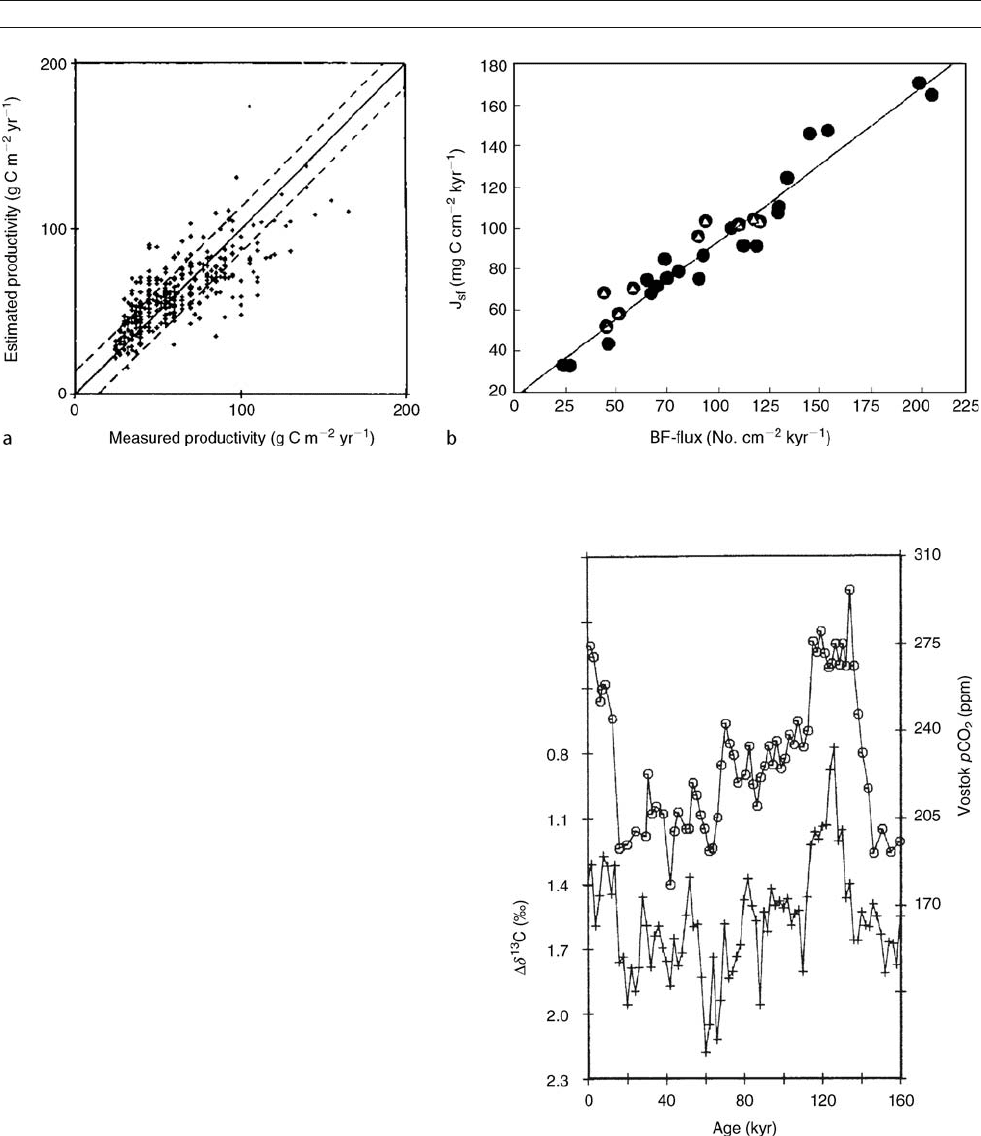
Reconstruction of productivity from carbon isotope
records
A link between ocean productivity and carbon isotopes was
first postulated by Tappan (1968), who suggested that change
in d
13
C of carbonates towards heavier values is indicative of
increased deposition of organic carbon, thus export production.
The principle underlying this relation is carbon mass balance.
During photosynthesis, since isotopically light carbon (
12
C) is
preferentially incorporated into the produced organic matter,
the residual inorganic pool will become enriched in
13
C. This
signature will be recorded in carbonate shells and therefore
higher d
13
C of carbonates indicates increased burial of organic
matter (with low d
13
C values) and hence higher productivity.
The difference between planktonic and benthic d
13
C compo-
sitions is a refinement of the above proxy (Figure O20). This
difference is controlled by both the photosynthesis of organic
matter in the surface ocean, which depletes the inorganic pool
of
12
C, and the regeneration of this organic matter at depth,
returning the
12
C to the deep-water inorganic pool. Thus, the lar-
ger the difference between the benthic and planktonic d
13
C(typi-
callyreferredtoasD
13
C), the higher the productivity (Shackleton
et al., 1983; Curry and Crowley, 1987; Schneider et al; 1994).
It must be kept in mind that changes in oceanic circulation
may modify the deepwater d
13
C independently of productivity.
Moreover, when benthic foraminifera species are used for d
13
C
analyses, it is important to choose species that indeed record
the isotope ratio of dissolved inorganic carbon in seawater
and not that of water within the sediment; thus only epifaunal
species (organisms living on top and not within the sediments)
should be used. In addition, because the isotopic fractionation
during photosynthesis and shell production may vary between
species and within each species depending on environmental
parameters (pCO
2
, carbonate ion concentrations, nutrient
availability, etc.) a record obtained from a single species is pre-
ferable (Duplessy et al., 1984). Reconstruction of paleoproduc-
tivity via carbon isotopes becomes less reliable the farther back
in time we go in the geological record. With now-extinct
Figure O19 (a) Estimated versus measured values for productivity as generated from foraminiferal transfer functions. (b) Accumulation rate of
benthic foraminifera (BF-flux) as a function of calculated flux of organic matter to the seafloor (Jsf) (after Berger and Herguera, 1992).
Figure O20 d
13
C difference (Dd
13
C) between the benthic foraminifera
Uvigerina sp. and the planktonic foraminifera Neogloboquadrina
dutertrei in core V19-30 in the eastern Equatorial Pacific (+ symbols)
(data from Shackleton and Pisias, 1985). Also plotted is the VOSTOCK
ice core pCO
2
data from Barnola et al., (1987) (o symbols). The similarity
between the records confirms the importance of export productivity
variations (the biological pump) to atmospheric CO
2
(figure modified
from Mix, 1985).
OCEAN PALEOPRODUCTIVITY 647
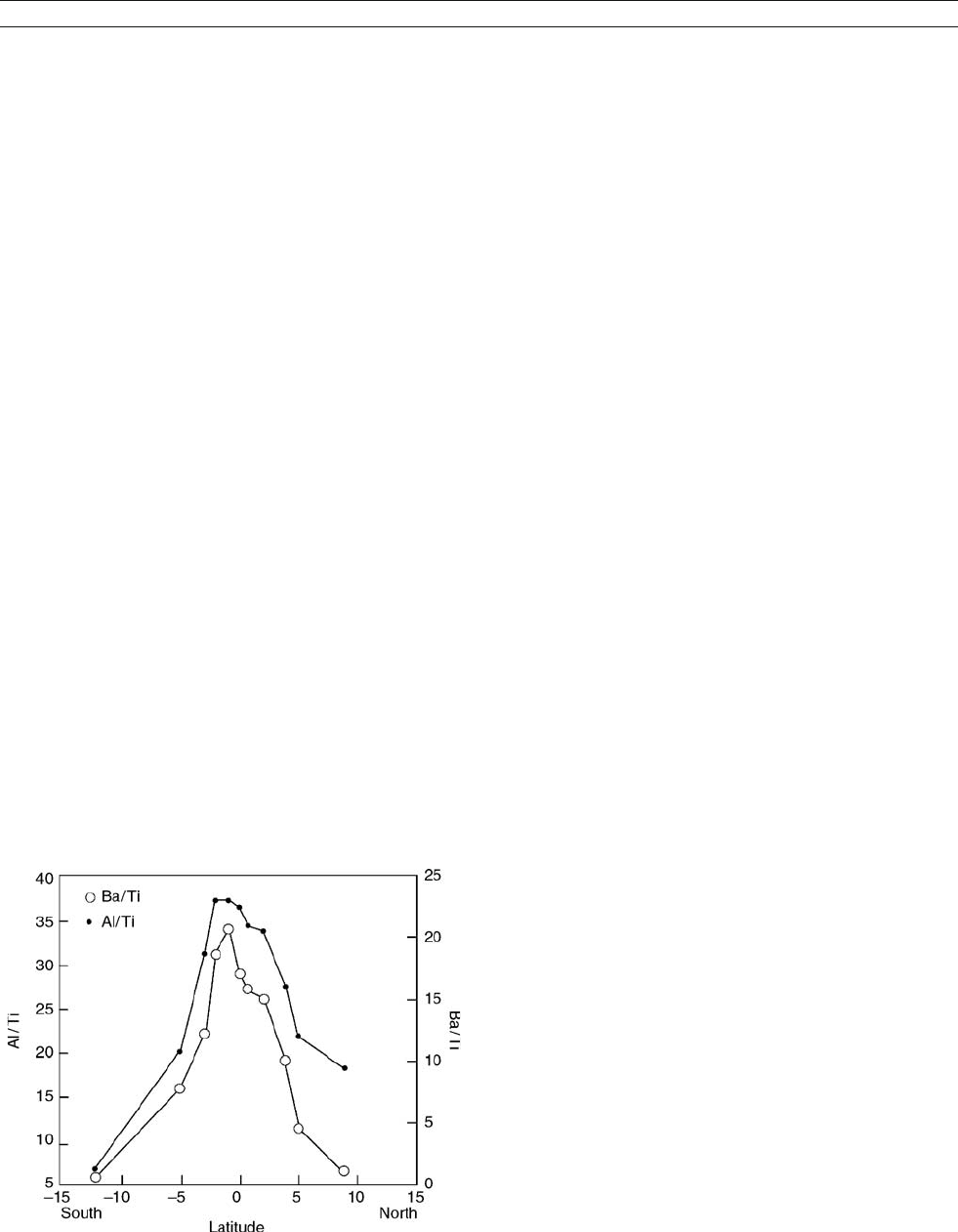
species, we can only indirectly verify the faithfulness of the C
signal in their skeletons to the ambient water d
13
C. In addition,
the extent of diagenetic modification of carbonate d
13
C in-
creases with time after burial and may be significant in areas
where pore fluids contain “light” methanogenically-derived C.
Reconstruction of productivity from geochemical
indicators
Several geochemical indicators that record particle flux in the
water column have also been used as proxies for productivity
(Al / Ti, Ba/ Ti,
231
Pa/
230
Th,
10
Be/
230
Th). In vast areas of the open
ocean, most of the particulate matter sinking in the water is of
biogenic origin and thus is related to productivity.
Application of bulk Al/Ti and Ba/Ti ratios assumes that
changes in the delivery of Al and Ba in non-lithogenic material
are proportional to particle flux, which may then be related/
converted to productivity. These proxy applications assume that
in specific open-ocean locations (with low terrigenous input), total
particle flux is proportional to C
export
(Murray et al., 2000). Since
Al is particle reactive, the adsorbed fraction of Al should increase
with increasing particle flux; therefore, the excess Al content of
deep-sea sediments (i.e., the fraction of Al not associated with alu-
minosilicate material) will increase with increasing particle flux
(Murray and Leinen, 1996). Similarly, Ba/Ti should co-vary with
bulk particle flux, and thus C
export
(Figure O21;Murrayetal.,
2000). Bulk ratio proxies apply so long as Ti is exclusively of
terrigenous origin, the fraction of Al or Ba associated with litho-
genic Ti does not change significantly through time, and the excess
Al or Ba is relatedto C
export
in a predictableand consistent manner.
The benefit of a normalizing ratio is that it does not require conver-
sion of concentrations to accumulation rates, thus avoiding errors
associated with such conversions.
In open ocean areas, a relationship exists between the mass
flux of particulate matter and the unsupported
231
Pa/
230
Th and
10
Be/
230
Th activity ratios of recent sediments (Anderson et al.,
1983; Rutsch et al., 1995). These ratios have been used as tracers
to assess changes in productivity. The production rate of
231
Pa
and
230
Th from dissolved U in seawater and the input of
10
Be to
the ocean are known; however, the removal of these elements is
not homogenous because they have variable residence times in
the ocean. Because
230
Th is more effectively scavenged, its flux
to the seafloor is nearly equal to its rate of production; in contrast
231
Pa and
10
Be have longer residence times, which allows transport
and preferential removal in high particle flux regions (Anderson
et al., 1983). Therefore, high
231
Pa/
230
Th and
10
Be/
230
Th ratios
indicate regions of extensive particle flux. The major advantage
of the radionuclide ratios is that they are less sensitive to post-
depositional diagenetic alteration. However, changes in ocean
ventilation rate and dependence of scavenging efficiency in
particle composition may influence the reliability of these proxies
(Walter et al., 1999).
Accumulation of redox-sensitive metals in marine sediments is
indirectly related to productivity, or more accurately, to the flux of
C to the sediment. The higher the export production and organic C
accumulation the more oxygen is consumed in the water column
and sediment. As pore waters become sufficiently reducing, some
metals precipitate and accumulate in the sediments. An example of
an element that has been linked to organic C flux is uranium,
which forms authigenic minerals in the sediment under reducing
conditions (Kumar et al., 1995). Laminated sediments have also
been linked to very high organic C fluxes. When the organic mat-
ter flux to the bottom waters is high, all of the dissolved oxygen
is consumed, resulting in anoxic waters and low abundance
of benthic organisms. This in turn reduces the degree of bioturba-
tion and preserves the lamination in sediments. The above proxies,
however, will also respond to changes in bottom water oxygen
over time that are related to circulation and ventilation of the ocean
and not to productivity, thus they are hard to interpret directly
as reflecting changes in biological productivity.
It has recently been suggested that another geochemical proxy,
the Sr/Ca ratio in coccolithophores, changes in proportion to cal-
cification rates, which are higher when coccolith productivity is
high (Stoll and Schrag, 2000). This proxy has been used for quali-
tative reconstruction of paleoproductivity; however, such recon-
struction will only represent changes in coccolith productivity,
which may be decoupled from total production. In addition, spe-
cies-dependent Sr uptake rates and diagenetic alteration of original
Sr/Ca ratios have not been completely ruled out and may comp-
licate interpretation.
Reconstruction of productivity from nutrient content
Nutrient (N, P, Fe, Si) availability in many places controls the
productivity in the surface ocean. Therefore, it has been sug-
gested that knowledge of nutrient concentrations or their degree
of utilizati on can be examined in the sedimentary record and
may provide indirect information about past productivity. Such
proxies include the nitrogen isotopic composition of organic mat-
ter (Altabet and Francois, 1994; Farrell et al., 1995), silicon iso-
topic composition of diatom frustules (De La Rocha et al.,
1998), and the Cd/Ca ratio of planktonic foraminifera (Cd serves
as an analog for P; Elderfield and Rickaby , 2000). The basic con-
cept behind these proxies is that in areas where the nutrient pool
(N, Si, P) in the surface ocean is not fully utilized, progressive
assimilation of nutrients from surface seawater , accompanied by
fractionation, produces strong gradients in the isotopic or elemen-
tal composition within the euphotic nutrient pool, which is then
recorded by the plankton. This in turn leads to corresponding
changes in the composition of particles that sink in the water col-
umn and accumulate in the sediment. For example, at high nutri-
ent content relative to uptake (low utilization rates),
14
Nis
preferentially taken up by the phytoplankton and the organic mat-
ter , which under such conditions will have low d
15
Nvalues.As
nutrients are more efficiently utilized, less isotopic discrimination
occurs and the d
15
N of organic matter shifts towards heavier
Figure O21 Profiles of Al / Ti and Ba /Ti trace productivity across a
meridional transect at 140
W in the central equatorial Pacific Ocean
(modified from Murray et al., 2000 and references therein).
648 OCEAN PALEOPRODUCTIVITY
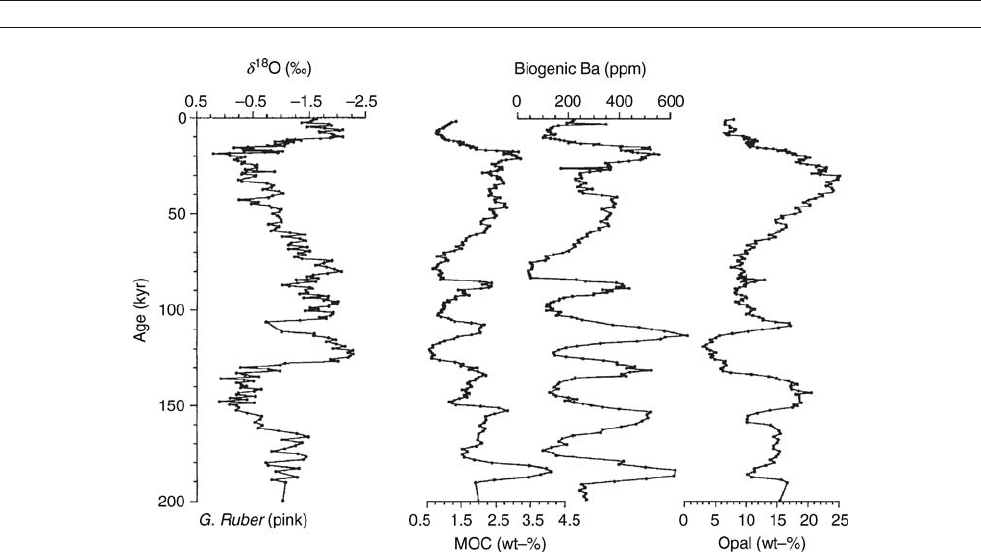
values. Similar uptake effects result in changes in the d
32
Si of dia-
toms and the Cd/Ca ratio in planktonic foraminifera.
It must be kept in mind, however, that the relation between
nutrient input and uptake (i.e., utilization) and biological pro-
ductivity is not straightforward. In addition, changes in the iso-
tope ratio or elemental composition of the bulk oceanic
reservoir and post-depositional changes cannot be ruled out
and may affect the sedimentary record (Montoya, 1994).
Reconstruction of productivity from organic
biomarkers
Algal class structure is intimately related to overall water
productivity and nutrients. Knowledge of the phytoplankton
community can help distinguish high productivity from low
productivity areas.
Marine phytoplankton, zooplankton and bacteria all synthe-
size a large number or organic compounds, many of which are
taxon specific. The relation between the occurrence of certain
compounds (biomarkers) and abundance of particular phyto-
plankton groups has been utilized to distinguish between mar-
ine and terrestrial organic matter and, in principle, could be
used to reconstruct community structure.
Efforts to develop these proxies are underway; however,
diagenesis is a major hurdle for quantitative reconstruction. In
addition, the extraction of specific organic compounds from
bulk sediment using solvents results in only partial recovery
and the resulting extracted fraction may not be necessarily
representative of the total organic matter.
Summary
Although ocean productivity is very important for understand-
ing the operation of the global carbon cycle at present and in
the past, reconstruction of past ocean productivity patterns
using empirical relations derived from present-day ocean char-
acteristics is not a trivial undertaking. Each one of the proxies
(methods) developed so far, although it contributes to our over-
all knowledge, has important limitations and therefore the best
approach is to use multiple proxies (Figure O22). Critical eva-
luation of the validity of assumptions associated with each
existing proxy and development of additional proxies will
result in more robust reconstructions of paleoproductivity and
understanding of the coupling and feedbacks between produc-
tivity, tectonics, and climate.
Adina Paytan
Bibliography
Altabet, M.A., and Francois, R., 1994. Sedimentary nitrogen isotopic ratio
as a recorder for surface ocean nitrate utilization. Glob. Biogeochem.
Cycles, 8, 103–116.
Altenbach, A.V., and Sarnthein, M., 1989. Productivity record in benthic
foraminifers. In Berger, W.H., Smetacek, V.S., and Wefer, G. (eds.),
Productivity of the Oceans: Present and Past. Berlin: Springer,
pp. 255–269.
Anderson, R.F., Bacon, M.P., and Brewer, P.G., 1983. Removal of 230-
Th and 231-Pa from the open ocean. Earth Planet. Sci. Lett., 62,7–23.
Arrhenius, G.O.S., 1952. Sediment cores from the East Pacific. Rep. Swed.
Deep. Sea. Exped. 1947–1948, 5, 228.
Bains, S., Norris, R., Corfield, R., and Faul, K., 2000. Termination of
global warmth at the Palaeocene/ Eocene boundary through produc-
tivity feedback. Nature, 407, 171–174.
Barnola, J.M., Raynaud, D., Korotkevich, Y.S., and Lorius, C., 1987.
Vostok ice cores provides 160,000-year record of atmospheric CO
2
.
Nature, 329, 408–414.
Berger, W.H., and Herguera, J.C., 1992. Reading the sedimentary record of
the ocean’s productivity. In Falkowski, P.G., and Woodhead, A.D.
(eds.), Primary Productivity and Biogeochemical Cycles in the Sea.
New York: Plenum Press, pp. 455–486.
Figure O22 A multi-proxy approach for reconstructing marine productivity. Marine organic carbon (MOC), biogenic Ba, and opal co-vary
down-core and show higher values during glacial periods (as indicated by the oxygen isotope record) in core GeoB 1008-3 from the South Atlantic
(modified from Schneider et al., 1997).
OCEAN PALEOPRODUCTIVITY 649
